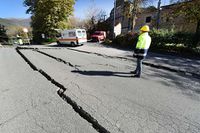Difference between revisions of "IS428 AY2019-20T1 Assign Tan Sok Yi"
(→Task) |
|||
| Line 1: | Line 1: | ||
<div style=background:#CD5C5C border:#A3BFB1> | <div style=background:#CD5C5C border:#A3BFB1> | ||
| + | [[Image:MC1-2019.jpg|200px]] | ||
<font size = 5; color="#FFFFFF">IS428 Visual Detective: Crowdsourcing for Situational Awareness </font> | <font size = 5; color="#FFFFFF">IS428 Visual Detective: Crowdsourcing for Situational Awareness </font> | ||
</div> | </div> | ||
Revision as of 13:47, 10 October 2019
|
|
|
|
|
|
Background
St. Himark has been hit by an earthquake, leaving officials scrambling to determine the extent of the damage and dispatch limited resources to the areas in most need. They quickly receive seismic readings and use those for an initial deployment but realize they need more information to make sure they have a realistic understanding of the true conditions throughout the city.
In a prescient move of community engagement, the city had released a new damage reporting mobile application shortly before the earthquake. This app allows citizens to provide more timely information to the city to help them understand damage and prioritize their response. In this mini-challenge, use app responses in conjunction with shake maps of the earthquake strength to identify areas of concern and advise emergency planners. Note: the shake maps are from April 6 and April 8 respectively.
With emergency services stretched thin, officials are relying on citizens to provide them with much needed information about the effects of the quake to help focus recovery efforts.
By combining seismic readings of the quake, responses from the app, and background knowledge of the city help the city triage their efforts for rescue and recovery
Task
The interactive visualisation created should allow:
- Emergency responders to base their initial response on the damage reports from citizens on the ground.
- Users to view the uncertainty in the data and compare the reliability of the neighbourhood reports
The analysis done on the below questions done will be based on the visualisations created:
- Emergency responders will base their initial response on the earthquake shake map. Use visual analytics to determine how their response should change based on damage reports from citizens on the ground. How would you prioritize neighborhoods for response? Which parts of the city are hardest hit?
- Compare the reliability of neighbourhood reports. Which neighborhoods are providing reliable reports? Provide a rationale for your response
- How do conditions change over time? How does uncertainty in change over time? Describe the key changes you see
